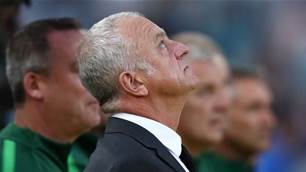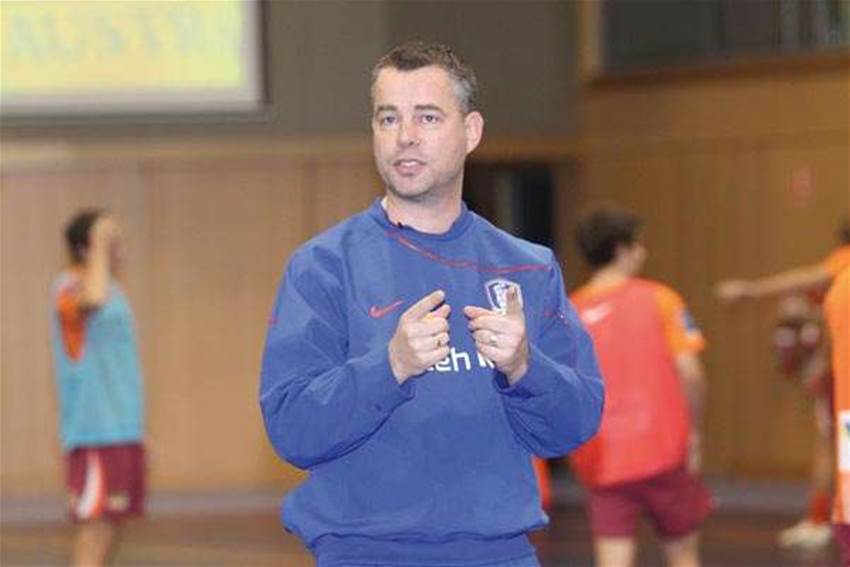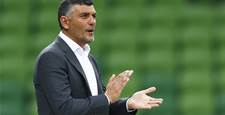Meet Raymond Verheijen – an outspoken advisor to A-League clubs and FFA
Meet Raymond Verheijen – the Dutch coach, and advisor to A-League clubs and FFA, who is not afraid to unleash a verbal volley.
In an age of agent approved comments and canned football clichés, there are few in the football environment who you feel are expressing their true feelings. That cannot be said of Dutch coach Raymond Verheijen.
Currently assistant coach at Wales, Verheijen is traditionally a fitness and conditioning coach with strong views on how players should be prepared. Verheijen is a hired gun who has been preaching his football-focused approach to getting players fit at World Cups, European Championships and clubs sides, including Barcelona, Chelsea and Manchester City, while he has also been a personal fitness coach to Craig Bellamy.
Verheijen is also rated highly by FFA and forms part of Australia’s coach education system under FFA technical director Han Berger and he has also worked with A-League clubs such as current champions Brisbane Roar. We caught up with Verheijen in the wake of Wales’s defeat to the Socceroos in Cardiff to learn more about his coaching philosophy and what needs to change in Australia.
Raymond, we’re looking forward to the interview as you have gained a reputation for speaking your mind in the media!
That has to do with the Dutch coaching culture. In Holland everyone is used to questioning things and making sure we always ask: why? That is the strength of Dutch football – people are constantly asking why things are going that way. That forces them and others to think twice about doing something. You develop as a coach and football develops too. This is why such a small country [Holland] has developed to such a high level. When this type of questioning is seen by another culture, people can react differently. Questioning is often seen as criticism by insecure people.
Can you outline your philosophy towards fitness and conditioning? And how does that differ to methods we see elsewhere?
Over the last decades fitness has been isolated from football. I always use a metaphor to explain that language is the main reason for this. Last June I delivered a course in Australia. For the first 30 seconds I spoke Dutch. So, a Dutchman from a world called Holland comes to a world called Australia but he keeps speaking his own language. Obviously, none of the Australian coaches could understand what I was saying. Thankfully, these coaches had no problem telling me I should be speaking the language that belongs to Australia. This seems to be a very simple example. However, in the football world where football people speak the football language it’s not so simple. Especially, when fitness coaches from the fitness world step into the football world and keep speaking their own fitness language with non-football words like aerobic, anaerobic, lactic and a-lactic. Even worse, these fitness coaches expect football people to understand these words. How arrogant is that? You would expect football coaches not to accept this in the same way they did not accept me speaking Dutch in Australia. Unfortunately, many football coaches are intimidated by these academic words. Some of them even start to speak the fitness language themselves. You can compare this with Australian coaches studying Dutch so they can understand me. The problem starts with coach education. When football associations deliver a coaching course one of the topics is fitness and conditioning. You would expect a football association to hire a football person to cover this topic in football language. However, they often hire a fitness coach who presents in fitness language and talks about training energy systems instead of improving football actions. As the participating coaches do not understand all these fitness words, they then develop the notion that fitness is something different to football. That is how fitness got isolated from football. The solution is to develop football fitness in football language and, consequently, in football exercises. That is what I have been doing for the last 15 years and I now deliver this message at 25 different Pro License courses around the world. I analyse and describe football and it does not matter what country I am in, everyone knows what I am saying – the football language is universal. In 2009 FFA technical director Han Berger invited me to deliver the football-specific approach in Australia as part of the new coach education structure. We have made big steps forward ever since. In Australia fitness has been integrated back into football. Basically, we brought fitness back home.
What is the key to improving your players’ fitness and performance?
You need to work with coaches who understand football. If you analyse and work in football, you soon figure out that if you want to go to a higher level of play, you need to deal with less space and time for football actions during a game. So, you need to increase your speed of actions. This means that football is predominantly an intensity sport, not an endurance sport. Many people in football train players like it is an endurance sport. They think it is 90 minutes, so it must be an endurance sport. If we were working in an endurance sport, then more would be better. However, as football is an intensity sport, training sessions should mainly focus on quality not quantity. As this results in an accumulation of fatigue which is the worst enemy of a football player. If you train too often or too long, at some stage players will start a training session already tired which means their speed of actions will decrease instead of improve. In football less is more. Most fitness coaches do not understand this because they do not have a deep understanding of the game.
Continues on next page...
You have said in the past that “Australian football is being strangled by non-football fitness coaches who run players into the ground and spoil football time”.
When I was first invited by FFA in 2009 they explained to me that football in Australia has a serious problem in terms of football fitness. The people of FFA described the problem to me that even at lower level and junior level, fitness coaches are doing isolated training and losing football time. Australia wants to catch up with the big nations and the main area that needs improvement is the technical and tactical area. These areas can only be improved by training football. So, the more time you spend in isolation, the less time you have to catch up with the big nations in terms of technique and tactics. That is how it was explained to me and that was the main reason I was invited to Australia, as my philosophy is to develop fitness as part of football training. This is more ‘training time efficient’ as football and fitness are developed at the same time. I have now visited Australia five times, met lots of people from across Australia and they were all saying the same thing as FFA.
You asked what century Newcastle Jets coach Branko Culina is from and suggested there is still a long way to go in Australia after details of their pre-season, which involved running up sand dunes, was revealed.
I only use those examples to illustrate the bigger picture. In the context of the Newcastle Jets this pre-season is no problem as it is the choice and responsibility of the head coach.
But in the context of the future of football in Australia, the media attention for this pre-season is detrimental as other coaches might copy these methods which would mean players will have less football time.
Some people in Australia might say you are “anti-sport scientist”. Is that true?
I think sport science has a lot to offer to football, potentially. It is also true that Australia is one of the world leaders in sport science. And it is logical that every country tries to use its strengths to reach the top. But people should understand that sport science is not the solution to develop Australia into a top 10 football country in the world. Thankfully, technical director Han Berger and his staff have developed the new football curriculum which will bring football in Australia to the next level.
Clubs who you have been vocal about in the past include Chelsea, Arsenal, Tottenham and Manchester City – what has been your objection to their methods?
The main reason for injuries in football is accumulation of fatigue. Injuries do not happen because of bad luck! Football players have made football actions all their lives. All of a sudden a hamstring or ligament snaps and that has to do with the status of the body at that particular moment: fatigued! The next question is: where is this accumulation of fatigue coming from? The main reason is imbalanced planning of training. It is very important that you are doing the right football training at the right moment and in the right sequence. As an example, if you play four versus four in training today, which is very demanding on the body, you will definitely be tired the next day. If you do sprint training or shooting exercises the next day, then an already fatigued body, with fatigued muscles, is doing more maximum explosive actions in a higher frequency than they normally would in a game. You are asking for trouble. You are overloading a fatigued body. This is just a simple example, but it is all about planning the right exercises, in the right sequence, at the right time, to avoid fatigue and injuries.
Wales recently hosted the Socceroos in Cardiff – what did you make of the Australians?
I said this to Holger Osieck and Aurelio Vidmar afterwards too – I was impressed. Australia did really well. They were well organised, they kept compact and were disciplined in defence. When in possession they had plenty of movement with the wingers coming inside and the full-backs getting high up the pitch. There was also a lot of variation from Australia. They knew exactly what they were doing. I also like the chemistry between the players and the coaching staff.
What does the future hold in terms of your involvement with FFA and Australia?
FFA have asked me to follow-up on my involvement on the coaching courses in 2012. I will probably be involved in the Euro 2012 Championships though, so I will have to see which country I work with there and what my schedule will be. Once I know my 2012 schedule, we will definitely do some follow-up courses in Australia.
This article appeared in the November 2011 issue of Australian FourFourTwo magazine. To buy back copies of this issue call 03-8317-8121 with a credit card to hand.
The current edition of Australian FourFourTwo has just gone on sale in newsagent across the country, or you can subscribe here
Related Articles

Backlash over Fox Sports new season launch

W-League, A-League set for world-first equal marketing split













